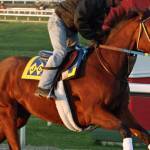Recurrent Exertional Rhabdomyolysis: A Muscle Problem in Horses

In contrast to sporadic exertional rhabdomyolysis (classic tying-up), horses with RER are fit, actively in work, and show signs of muscle soreness after less than maximal exercise.
Racehorses affected with RER exhibit clinical signs when they are only galloped or worked at a slower pace. Eventers may show signs during the cross-country or steeplechase phase when they are held back at slower speeds. The underlying defect of RER appears to be caused by a defect in muscle contraction and excitation, possibly related to calcium release in the muscle. Young, highly excitable fillies are more likely to be affected. Diagnosis of RER is made from clinical signs, elevated muscle enzyme activities, history, and microscopic signs of muscle damage and/or repair seen on muscle biopsy.
Clinical signs of RER are more likely to occur in horses fed a high-grain diet (> 10 lb [4.5 kg]/day). Treatment involves reducing dietary carbohydrate and supplementation of calories with fat. Rather than affecting how horses use carbohydrates for energy, high-fat diets are believed to lower blood glucose, insulin, and cortisol concentrations, which may have a hormonal affect to relieve anxiety and reduce the tendency to tie-up in horses with RER.
Horses with RER tend to be fit and in active training; therefore, the required calories for work are supplemented with fat to compensate for reduced carbohydrate intake. Unless clinical signs of myositis are severe, it is recommended that horses affected with RER remain in some degree of work or at least be turned out. Affected horses have a greater increase in muscle enzymes after a period of rest, compared to when they remain in work.
Stress reduction is also important to reduce RER episodes, so diagnosed horses should be turned out as much as possible (with herdmates if the horse prefers), should be fed first to reduce anxiety at feeding time, and may benefit from being housed in a stall situated away from the hustle and bustle of the stable (furthest from wash or grooming bays or well-used thoroughfares such as a route to an indoor arena or training track).








